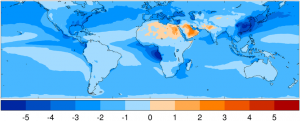Air quality made recent headlines when a thick layer of pollution spread over southern England in early April. Reports stressed the hazards posed by pollution particles to our health, but pollution has another, more unexpected impact: it contributes to climate change, primarily by opposing the warming due to greenhouse gases.
The atmosphere contains a large number of tiny solid or liquid particles called aerosols. Some of those aerosols come from natural sources: sand storms, sea spray, or even the pollens emitted by plants. But we add to natural levels through transport, energy generation, industry, heating, and agriculture – that is the pollution we saw a few weeks ago. The aerosols we emit have competing effects on the Earth’s climate. On the one hand, they cool the climate by preventing sunlight from reaching the surface. It is darker under a plume of pollution than under clear skies, and aerosols also lead to the formation of brighter clouds, which in turn reflect more sunlight back to space. On the other hand, aerosols made of soot are black, and warm the climate by absorbing more sunlight within the atmosphere. Climate change is the result of the tug of war between the warming caused by greenhouse gases and soot aerosols, and the cooling caused by the other aerosol species. We know that the warming side is winning, but a key question is: by how much?
To answer that question, I work with British and European colleagues on a large project called MACC (Monitoring Atmospheric Composition and Climate), funded by the European Union. MACC produces daily global and European forecasts of atmospheric aerosols, creating an expanding record that started in January 2003. We use that record to routinely monitor the impact of man-made aerosols on climate. We estimate that man-made aerosols reflect back to space an average of 1 watt for every square metre of the planet. This cancels out just less than one third of the 2.6 watts per square metres added to the Earth’s energy budget by man-made increases in greenhouse gas concentrations. The image below shows where the effect of man-made aerosols is strongest. As expected, the industrialised regions of Europe, North America, India, and China appear clearly. Regions over the oceans also stand out, because pollution transported from the nearby land makes maritime clouds brighter there. The gain of energy due to soot aerosols is included in that picture, but is generally masked by the stronger loss of energy due to other aerosols: it only dominates over desert regions, where the surface itself is very reflective.
This figure shows the distribution of changes in top-of-atmosphere energy budget (in watts per square metre) due to man-made aerosols, on average over the period 2003–2012. Blue colours indicate net losses of energy, which cause cooling. Red colours indicate gains of energy, which cause warming. The map is restricted to the 60°S–60°N latitude range, where satellite observations of aerosols and clouds are best.
Estimating the impact of aerosols is not easy. First, the amount of aerosols emitted into the atmosphere by human activities is not well known. Then, aerosols only remain in the atmosphere for a few days before being washed out by precipitation, so pollution levels vary considerably in time and space. Whereas an accurate global picture of carbon dioxide concentrations can be obtained by taking measurements just over Hawaii, we need frequent observations by sophisticated satellite instruments to monitor global aerosol concentrations properly. Finally, aerosols undergo chemical and physical transformations in the atmosphere, which affect their ability to interact with sunlight and clouds. For those reasons, although the MACC best estimate of the aerosol climate impact is 1 watt per square metre, we determined that those impacts could be as little as 0.5 watts or as much as 2 watts. One thing is known for certain, though: as we decrease aerosol emissions to improve the quality of the air we breathe, we are leaving an increasing fraction of greenhouse gas warming unopposed. MACC and other projects help to solve that dilemma.
For more detailed information:
Bellouin, N., Quaas, J., Morcrette, J.-J., and Boucher, O., 2013. Estimates of aerosol radiative forcing from the MACC re-analysis. Atmos. Chem. Phys., 13, 2045-2062, doi:10.5194/acp-13-2045-2013. Available in open access here.

